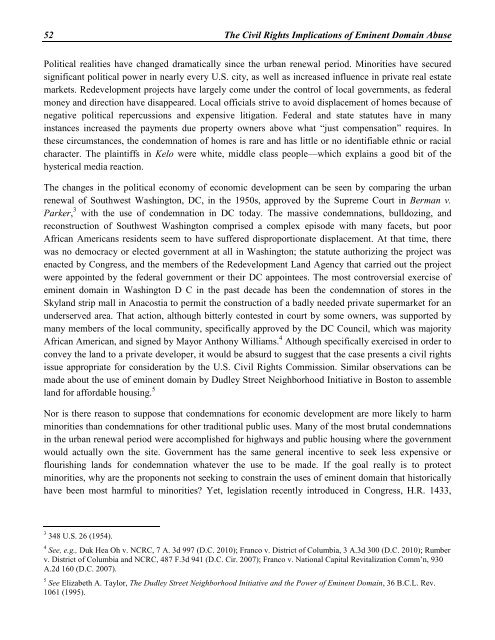Create successful ePaper yourself
Turn your PDF publications into a flip-book with our unique Google optimized e-Paper software.
52 The Civil Rights Implications of <strong>Eminent</strong> <strong>Domain</strong> AbusePolitical realities have changed dramatically since the urban renewal period. Minorities have securedsignificant political power in nearly every U.S. city, as well as increased influence in private real estatemarkets. Redevelopment projects have largely come under the control of local governments, as federalmoney and direction have disappeared. Local officials strive to avoid displacement of homes because ofnegative political repercussions and expensive litigation. Federal and state statutes have in manyinstances increased the payments due property owners above what “just compensation” requires. Inthese circumstances, the condemnation of homes is rare and has little or no identifiable ethnic or racialcharacter. The plaintiffs in Kelo were white, middle class people—which explains a good bit of thehysterical media reaction.The changes in the political economy of economic development can be seen by comparing the urbanrenewal of Southwest Washington, DC, in the 1950s, approved by the Supreme Court in Berman v.Parker, 3 with the use of condemnation in DC today. The massive condemnations, bulldozing, andreconstruction of Southwest Washington comprised a complex episode with many facets, but poorAfrican Americans residents seem to have suffered disproportionate displacement. At that time, therewas no democracy or elected government at all in Washington; the statute authorizing the project wasenacted by Congress, and the members of the Redevelopment Land Agency that carried out the projectwere appointed by the federal government or their DC appointees. The most controversial exercise ofeminent domain in Washington D C in the past decade has been the condemnation of stores in theSkyland strip mall in Anacostia to permit the construction of a badly needed private supermarket for anunderserved area. That action, although bitterly contested in court by some owners, was supported bymany members of the local community, specifically approved by the DC Council, which was majorityAfrican American, and signed by Mayor Anthony Williams. 4 Although specifically exercised in order toconvey the land to a private developer, it would be absurd to suggest that the case presents a civil rightsissue appropriate for consideration by the U.S. Civil Rights Commission. Similar observations can bemade about the use of eminent domain by Dudley Street Neighborhood Initiative in Boston to assembleland for affordable housing. 5Nor is there reason to suppose that condemnations for economic development are more likely to harmminorities than condemnations for other traditional public uses. Many of the most brutal condemnationsin the urban renewal period were accomplished for highways and public housing where the governmentwould actually own the site. Government has the same general incentive to seek less expensive orflourishing lands for condemnation whatever the use to be made. If the goal really is to protectminorities, why are the proponents not seeking to constrain the uses of eminent domain that historicallyhave been most harmful to minorities? Yet, legislation recently introduced in Congress, H.R. 1433,3 348 U.S. 26 (1954).4 See, e.g., Duk Hea Oh v. NCRC, 7 A. 3d 997 (D.C. 2010); Franco v. District of Columbia, 3 A.3d 300 (D.C. 2010); Rumberv. District of Columbia and NCRC, 487 F.3d 941 (D.C. Cir. 2007); Franco v. National Capital Revitalization Comm’n, 930A.2d 160 (D.C. 2007).5 See Elizabeth A. Taylor, The Dudley Street Neighborhood Initiative and the Power of <strong>Eminent</strong> <strong>Domain</strong>, 36 B.C.L. Rev.1061 (1995).


